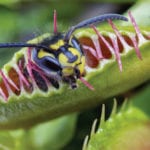 Technology
Technology  Technology
Technology  Humans
Humans 10 Everyday Human Behaviors That Are Actually Survival Instincts
 Animals
Animals 10 Animals That Humiliated and Harmed Historical Leaders
 History
History 10 Most Influential Protests in Modern History
 Creepy
Creepy 10 More Representations of Death from Myth, Legend, and Folktale
 Technology
Technology 10 Scientific Breakthroughs of 2025 That’ll Change Everything
 Our World
Our World 10 Ways Icelandic Culture Makes Other Countries Look Boring
 Misconceptions
Misconceptions 10 Common Misconceptions About the Victorian Era
 Mysteries
Mysteries 10 Strange Unexplained Mysteries of 2025
 Miscellaneous
Miscellaneous 10 of History’s Most Bell-Ringing Finishing Moves
 Technology
Technology Top 10 Everyday Tech Buzzwords That Hide a Darker Past
 Humans
Humans 10 Everyday Human Behaviors That Are Actually Survival Instincts
 Animals
Animals 10 Animals That Humiliated and Harmed Historical Leaders
Who's Behind Listverse?

Jamie Frater
Head Editor
Jamie founded Listverse due to an insatiable desire to share fascinating, obscure, and bizarre facts. He has been a guest speaker on numerous national radio and television stations and is a five time published author.
More About Us History
History 10 Most Influential Protests in Modern History
 Creepy
Creepy 10 More Representations of Death from Myth, Legend, and Folktale
 Technology
Technology 10 Scientific Breakthroughs of 2025 That’ll Change Everything
 Our World
Our World 10 Ways Icelandic Culture Makes Other Countries Look Boring
 Misconceptions
Misconceptions 10 Common Misconceptions About the Victorian Era
 Mysteries
Mysteries 10 Strange Unexplained Mysteries of 2025
 Miscellaneous
Miscellaneous 10 of History’s Most Bell-Ringing Finishing Moves
10 Fascinating and Useful Examples of Vomiting in Nature
Most people prefer not to think about vomiting, but it serves some peculiar purposes in the animal kingdom. From building social bonds to seeing off predators, the uses for puke seemingly know no bounds. Let’s explore the most bizarre and ingenious examples of valuable vomit in nature.
Related: Top 10 Animals With Creepy Behaviors
10 Hyenas Having Fun
If you vomit, chances are you want to clean it up as fast as possible—not just because it’s gross, but to avoid infecting others with the same bug that left you heaving. Not so for the spotted hyena. This creature is well-known for its sturdy immune system, which allows it to fight off rabies, canine distemper virus, and even anthrax with relative ease. It also loves nothing more than rolling in its own (and other’s) throw-up.
A biology student from Michigan State University describes the phenomenon in eye-watering detail on the MSU Hyena Research blog. According to her, the animals will excitedly attempt to barge each other out of the way to roll in puke whenever a pack member throws up, even becoming aggressive to secure access. Even the oldest animals charge at the pool of vomit, which the researchers describe rather colorfully as “sliding into a very stinky home plate.”[1]
9 Defensive Turkey Vultures
Vomit repulses most humans, and the same is true of much of the animal kingdom. The turkey vulture uses this natural aversion to its advantage by puking on any animal that threatens or harasses it. It has an impressive reach, projecting puke up to 10 feet (3 meters) to keep potential predators at bay.
Projectile vomiting isn’t the turkey vulture’s only unsavory habit. After enjoying a meal, these scavengers defecate on their own feet. While this practice may seem disgusting, it serves a valuable purpose for the turkey vulture. Its poop cools its feet down and acts as a natural antiseptic, killing any potentially harmful bacteria picked up from tearing at rotting meat.[2]
8 Bald Eagles Eating Turkey Vulture Vomit
It’s not hard to see why Thomas Jefferson chose the bald eagle as the national emblem of the United States. This majestic bird has the appearance of a noble hunter, but the truth is slightly less impressive. Bald eagles are descended from vultures, and although they sometimes hunt, they prefer scavenging prey from ospreys and other predators whenever they can. In fact, Benjamin Franklin considered the bald eagle too cowardly to be symbolic of a new nation, preferring the less flashy charms of the humble turkey.
Scavenged fish forms a significant part of the bald eagle’s diet, but that’s not the only thing on the menu. These fierce-looking birds are partial to turkey vulture vomit and go significantly further than feasting on puke left on the ground. Bald eagles are known to bother turkey vultures until they projectile spew, providing them with an instant meal.[3]
7 Regurgitating Flies
You’ve probably heard that house flies vomit on human food, but the reality is much, much worse. Researchers from the University of Massachusetts Amherst say that house fly throw-up can contain rotting roadkill, garbage, and even animal poop.
House flies have an internal chamber called a crop where they keep food before it passes through their digestive systems. When it finds its next meal, it partakes in an activity known as “bubbling.” Bubbling entails vomiting out excess water from the crop to make space for a bite of your meal—a little like loosening your belt to make room for more Christmas dinner. However, a spray of undigested food inevitably exits alongside the water. If that happens to be feces or sewage, it could make your sandwich a whole lot less appetizing.
Researchers now know that house fly crops contain minimal digestive enzymes or peptides to kill potentially disease-causing pathogens. Furthermore, bacteria dwelling in a fly’s crop are more likely to become resistant to antibacterial treatments. While there’s a lot scientists still don’t know about fly puke, it’s certainly wise to avoid leaving food out to become a housefly’s next meal.[4]
6 Attracting a Mate
When you think of romantic gifts to drive a partner wild with desire, flowers, chocolates, or jewelry probably spring to mind. Not so for Drosophila subobscura, a type of fruit fly originally native to the Mediterranean but now found across Europe, the Near East, and parts of the United States and Canada. The males provide females with a “nuptial gift” of regurgitated liquid, and it turns out the females can’t get enough of it. Research shows that the more drops of vomit the male provides, the greater his chances of mating successfully. Furthermore, eating the offerings even makes females in poor physical condition more fertile.
Fruit flies aren’t the only creatures using vomit to attract mates. A crustacean called an ostracod has an entire organ devoted to creating bioluminescent compounds irresistible to females. When it wants to attract a mate, the muscles around its organ contract to send jets of the glowing compound out of its mouth. Some sneaky males even tag along, taking advantage of another male’s display without producing their own.[5]
5 Puking Nestlings
If a terrifying experience has ever made you want to puke, you’ll sympathize with baby Eurasian rollers. Nestlings produce stinky orange puke when they sense danger. Scientists believe that puking at the sight of a threat is probably partially defensive, but it also warns their parents that predators are nearby.
So, what do adult Eurasian rollers do when they smell their offspring’s distress? Save themselves, according to Spanish scientists. Parents generally skip feeding their babies and avoid the nest until the smell dissipates. However, don’t judge mommy and daddy roller too harshly. Getting eaten by a predator leaves their offspring with no one to feed them, so this behavior could increase the chance of some of their babies surviving.[6]
4 Stomach Rinsing
If you can’t vomit in the traditional sense, it’s handy to have another way to remove indigestible food and other unpleasantness from your stomach. Several species throw up their entire stomachs through their mouths in a process known as eversion. Scientists don’t know exactly how these creatures achieve this impressive feat, but it’s thought that they relax the muscles supporting their digestive system while increasing pressure in the abdomen.
In the case of stingrays, everting their stomachs allows them to rinse unwanted debris, such as animal shells, large chunks of fish, and mucus. Chinstrap penguins, meanwhile, vomit up their stomach linings to get rid of excess fluoride. However, frogs and toads provide probably the weirdest example of stomach eversion, using their right hands to wipe the insides of their stomachs clean.
Why the right hand? That question caught the attention of Delilah Foss, a writer at Improbable Science. Determined to find out whether frogs and toads really are right handed, she wrote to Richard Wassersug at Dalhousie University for answers. It turns out that everted frog and toad stomachs always hang out of the mouth slightly to the right, solving the mystery of these slimy creatures’ apparent right handedness.[7]
3 Feeding Friends
Vampire bats have fascinating social lives, developing complex bonds to help them survive. These sophisticated interactions involve vomiting blood into each other’s mouths.
Scientists have observed vampire bats sharing regurgitated blood meals since the 1980s, but recent research shows that this behavior helps ensure survival for the vomiter and the vomitee. Gerald Carter of the Smithsonian Tropical Research Institute spent an impressive three years watching captive animals in a Michigan zoo to figure out how vampire bat vomit currency works.
First, Carter noted which animals offered vomit meals to which individuals. He then separated certain bats from the group for 24 hours without food before reintroducing the hungry creatures to the colony. Watching which bats received generosity from others revealed a “tit-for-tat” structure that seems incredibly human. Female bats that had previously been generous with providing blood meals received more regurgitated offerings than creatures with a track record for selfishness, with many animals refusing to feed individuals that hadn’t helped them in the past.[8]
2 Making Honey
The idea that honey is bee vomit is enough to put you off your breakfast. Fortunately, it turns out that this commonly-held belief is false, although it isn’t far off the truth.
So, if honey isn’t bee puke, what is it? To answer that question, we need to think back to our friend, the housefly. Like houseflies, bees have a crop where they store nectar. A membrane prevents food from passing between the bee’s gut and the crop, so there’s definitely no bee barf in your honey jar.
However, what happens in the crop, or “honey stomach,” is pretty interesting. Enzymes from the bee’s saliva get to work converting starch to sugar and producing hydrogen peroxide to stop bacteria from infecting the nectar. The crop also contains a bristled valve that works a little like a broom, removing pollen and parasitic spores from the mixture.
Next, things get a little more pukey. The bee regurgitates the honey to another bee that also does the same, each time adding more enzymes. The bees repeat this process several times, swallowing and regurgitating the nectar until the mixture is ready. Once the honey reaches the right consistency, the bee pumps it through its mouth into the honeycomb. Then the bee uses its wings like a fan to remove excess water, drying it out until it forms honey..[9]
1 Morning Sickness
Pregnancy can be an uncomfortable experience, not least because morning sickness affects around two-thirds of women in the first trimester. However, the name “morning sickness” is a tad misleading. Many mothers will attest that nausea and vomiting can strike any time of the day or night, potentially leading to a miserable 12 weeks.
At first glance, morning sickness seems like a biological mistake—surely throwing up your meals is a bad thing when nutrition during pregnancy is so important? On the contrary, it turns out that this phenomenon could help protect a developing fetus and its mother. A 2000 review by scientists at Cornell University concluded not only that morning sickness reduces the risk of miscarriage significantly but also that actually, vomiting provides more protection than merely feeling sick to your stomach. But why?
The researchers believe that vomiting reduces the risk of contracting a food-borne infection. Considering that pregnancy suppresses immunity to stop the body from rejecting the growing embryo, a bout of food poisoning is more dangerous during this time— especially in weeks six through eighteen, when the baby’s development is most prone to disruption. That’s probably also why pregnancy causes aversions to foods most likely to contain harmful pathogens, such as meat, chicken, and fish.[10]








